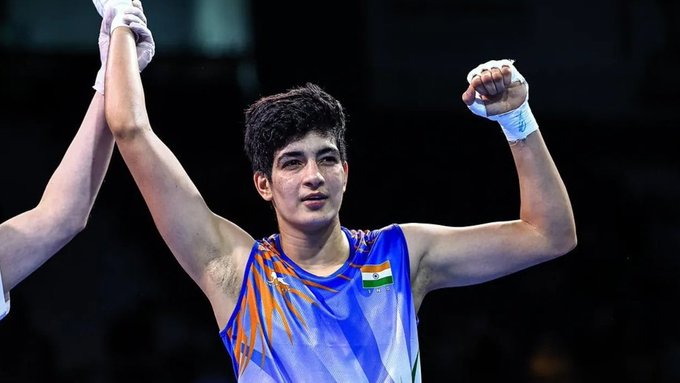
India is set to lose the Asian Games women’s 63kg class boxing bronze medal won by Parveen Hooda in Hangzhou last year after she was handed a 22-month ban beginning September 17, 2023, for whereabouts failures by the International Testing Agency (ITA), which handles the International Boxing Association’s (IBA) anti-doping matters.
Since her results obtained between December 1, 2022, and May 17, 2024, have been disqualified, it can be inferred that the Olympic Council of Asia will ask her to return the Asian Games bronze. Worse, since the ban lasts until July 16, 2025, the World No. 3 and 2022 World Championship medalist has to give up dreams of winning a medal at the Paris 2024 Olympic Games.
Ignoring the loss of the Asian Games medal and a potential Olympic Games podium finish, Boxing Federation of India (BFI) officials said last week that BFI was happy the boxer’s suspension period was reduced and that she would be back in the ring soon. The BFI found a convoluted way to say that the ban would actually last only 14 months rather than 22 as declared by ITA.
We were also told that Parveen’s failure to comply with whereabouts arose solely on account of her lack of knowledge and technical understanding of the Anti-Doping Administration and Management System (ADAMS). We were left scratching our heads, wondering why athletes from humble backgrounds, with little education, are left to their own devices.
You may ask whose responsibility is it to file whereabouts on ADAMS which is a web-based database management tool for athletes on a Registered Testing Pool to inform the anti-doping officials of their presence at a designated location for an hour each day. The logical answer is that this is the responsibility of the athlete, since only she or he will know her or his movements.
However, since Parveen may not have accessed her email to even know that she had been placed on NADA’s RTP, would it not be the federation’s duty to ensure that the athlete is provided with the right information to avert such disastrous consequences? After all, it engages a number of coaches and support staff and could easily have averted the crisis.
For the Latest Sports News: Click Here

While it is a given that the athlete alone is responsible for Anti-Doping Rule Violations (ADRV), two questions come up. Since NADA would have marked a copy of the e-mail intimating athletes of potential ADRVs to the concerned national sports federation, the questions relate to the BFI official/staff member with access to alerts that Parveen was defaulting on whereabouts.
First, did the BFI official/staff member set the alarm bells ringing and alert the coaching staff at the national camp where Parveen was training? Second, did the official/staff member not realise that letting her compete in the Asian Games was fraught with risk after she had clocked three whereabouts failures?
It is important to remember that the Athletics Federation of India (AFI) recalled race walker Bhawna Jat from Budapest just ahead of the World Athletics Championships in August last year as she was said to have been notified of her third whereabouts failure in the span of 12 months.
ITA overlooks imposition of provisional suspension
Things would not have come to such a pass had the International Testing Agency placed Parveen on provisional suspension as soon as she had a third whereabouts failure. The World Anti-Doping Agency (WADA) Code Article 7.4.1 specifies that provisional suspension is mandatory when there is an Adverse Analytical Finding or an Adverse Passport Finding.
Was a provisional suspension imposed on Parveen in the wake of her three whereabouts failures? A reading of the ITA notification of the boxer’s sanction does not indicate if Parveen has been placed on provisional suspension and if that period was taken in to account when adjusting the period of ineligibility.

However, it would appear as if ITA overlooked Article 7.4.2 of both the WADA Code and the IBA Anti-Doping Rules permitting the Result Management Agency to impose provisional suspension for ADRVs not covered under Article 7.4.1.
The Athletics Integrity Unit, which manages the anti-doping proramme for World Athletics, has been known to place athletes on provisional suspension for whereabouts failures. Closer home, the National Anti-Doping Agency (NADA) did that with wrestler Seema Bisla as well as track and field athletes G Lakshmanan and Akash Kumar Patel.
Lakshmanan and Akash were both notified of their respective three failures on August 10, 2023, a day after their third whereabouts failures, and placed on provisional suspension with immediate effect. After the ADDPs heard their case, they ordered two-year bans for both starting from the date of his provisional suspension.
Earlier, Seema copped a one-year ban for a combination of two whereabouts filing failures and a missed test. The ADDP took into consideration that having missed a test on December 2, 2022, Seema was tested later in the day and that test showed up as dope negative. It held her in violation of the rules and gave the least sanction possible.
Pooja Dhanda also had two filing failures in July and October 2022 and a missed test in December that year. Her ban, which commenced on June 15, 2023, was restricted to one year since the ADDP noted that she had offered to provide a sample on the day she has missed the test in a different location to the one she had specified in ADAMS.
As reported earlier, WADA investigators forced India to bridge gaps in anti-doping-programme. Despite that, the lesson from the Parveen episode has come along with enormous cost – an Asian Games medal and an Olympic quota. But will the Indian sports ecosystem own up responsibility and ensure that no such failure haunts the nation ever again?
Also Read: Learning from Virat Kohli’s motivational speech in the RCB dressing room




